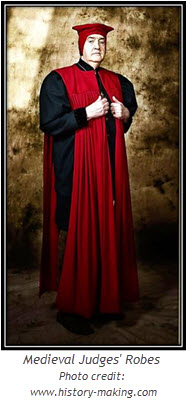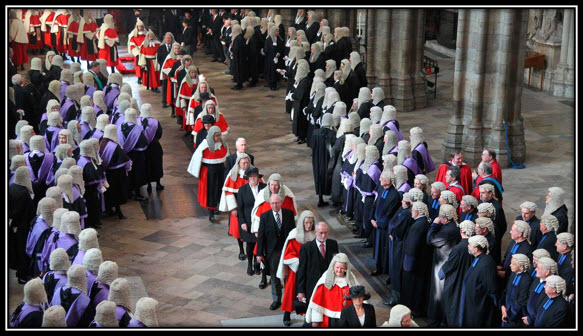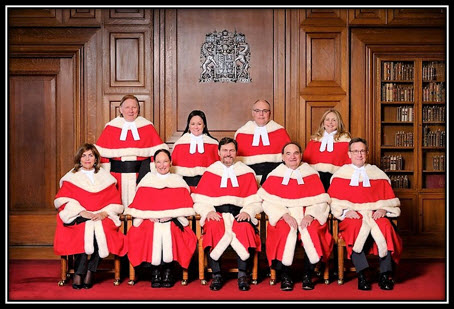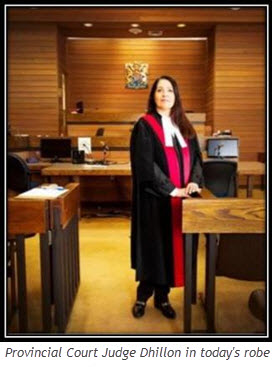Available as a podcast!
The clothes Canadian judges wear while working are certainly distinctive – long black robes whose trim colour and design vary according to the court. But have you ever wondered why Canadian judges wear robes?

It’s partly a matter of tradition. Historians seem to agree that the practice of English judges wearing robes dates back seven centuries. In the 1300s robes were worn by scholars at universities and aristocrats attending the royal court. When lawyers were granted the right to appear in law courts they wore robes or gowns as a symbol of that privilege. The clerics and knights who acted as judges donned robes as well, although theirs were richly trimmed and made of costly material in gorgeous hues – scarlet, green and violet. During the middle ages judges wore different coloured robes for each season, and often received the textiles needed to make their robes as a gift from the king (something that would infringe judicial independence and violate judicial ethics today).
In the 1600s English judges adopted guidelines – a sort of dress code – indicating the occasions and seasons when certain robes should be worn. A decree issued by the judges at Westminster in 1635 established summer and winter garb:
The facing of their Gownes, Hoods and Mantles is with changeable Taffeta; which they must begin to wear upon Ascension Day, being the last Thursday in the Easter term; and continue those Robes until the Feast of Simon and Jude; and upon Simon and Jude’s day, the Judges begin to wear their robes faced with white furs of Miniver; and so continue facing until Ascension Day again.
Miniver is apparently white fur - ermine or squirrel. Lawn Coyfes were likely caps made of fine fabric.
Later that century judges in England began to wear black robes, a practice that may have spread during mourning periods for King Charles II in 1685 and Queen Mary in 1694. By the 1680s, judges and lawyers had also replaced the ruffs worn as collars during Elizabethan times with two rectangles of linen, tied at the throat – the “tabs” still worn by judges and lawyers today with a winged shirt collar. By the 1700s, new guidelines were adopted mandating black robes, although scarlet robes were still to be worn for criminal trials and ceremonial occasions, and violet for other trials.

English judges in ceremonial wigs and robes, with barristers (lawyers)
in wigs and gowns observing at bottom right, in 2013
Photo credit: www.lawgazette.co.uk
Although English judges originally wore coloured caps and hoods matching their robes, they began wearing horsehair wigs in the 1600s when they were the style in society. The practice was not just fashionable – apparently it had health benefits. It’s said that wearing a wig on a shaved head prevented the spread of lice. As wigs disappeared outside courts in the 1700s, judges’ wigs gradually became smaller, but English judges and lawyers and those in some Commonwealth countries continue to wear them even today.
After Europeans came to North America, judges’ wigs and robes crossed the Atlantic along with the British common law on which our legal system is based. The first legally trained judges in British Columbia came from England and brought with them English judicial robes. For more than 80 years, some British Columbia judges and lawyers wore wigs, although they were expensive and uncomfortable in warm weather. Even after the provincial legislature passed a law banning wigs in BC courts in 1905, one judge - Mr. Justice Archer Martin - wore one when he presided in the federal Admiralty Court and insisted that lawyers did too.
Supreme Court of Canada
In photographs you often see the judges of the Supreme Court of Canada in scarlet fur-trimmed robes that some have compared to Santa suits. These robes, trimmed with white mink, are ceremonial robes reserved for special occasions in the Court, Senate or Parliament. In the CPAC video, Inside the Supreme Court of Canada: The Robes, Justice Andromache Karakatsanis confides that they’re hot and heavy to wear, with two or three layers of fur in some areas.

For daily court sittings, the judges of Canada’s highest court wear much more comfortable black silk robes.
Provincial Court of BC
In BC’s early days its magistrates, the non-legally trained predecessors of Provincial Court judges, did not wear robes. They travelled the province on horseback or whatever transportation was available, dealing with civil disputes of varying levels and summary conviction offences – and they dressed for their lifestyle. In Magistrate-Judge, The Story of the Provincial Court of British Columbia, Alfred Watts, QC, described one magistrate who served from 1864 to 1888 as wearing “Irish tweeds, coat and riding breeches”.

By the 1950s magistrates in Vancouver and Victoria were wearing robes, and in 1967 magistrates throughout the province were issued with robes which some, but not all, wore. After the creation of the Provincial Court in 1969 some judges robed, and some wore business suits, while others dressed casually.
Seeking consistency and dignity reflecting the Court’s role in the administration of justice, in 1975 the BC Provincial Court Judges Association passed a resolution adopting the style of robe worn today. The Chief Judge agreed, and since then BC’s Provincial Court judges have worn black robes with red facing down the front and around the cape collar when they preside in court. Under their robes they wear a white shirt, black vest and white tabs or a decorative collar.
For settlement and family case conferences Provincial Court judges sometimes wear business clothes, in keeping with the less formal conference setting.

Some BC Provincial Court judges still travel extensively, carrying their robes by float plane, boat or SUV to the remote locations where they hold court. As Alfred Watts QC wrote about their predecessors, “One must have considerable admiration for those who constantly travel in difficult areas but always ensure that the dignity of the court is so upheld.” 
More than tradition
Granted, judges’ robes are a tradition – one they maintained long after styles changed and other segments of society embraced different fashions. But it’s a tradition that serves a purpose today. Judges’ robes lend dignity to judicial proceedings, distinguish independent courts from other decision-making tribunals, and remind people of the important role our courts play in a democratic society - resolving disputes peacefully and fairly, and upholding our constitution and the rule of law.
References:
“A Brief History of Court Attire", (2006) 64 The Advocate 65-77
"Judicial Robes", (1952) 10 The Advocate 109-111

